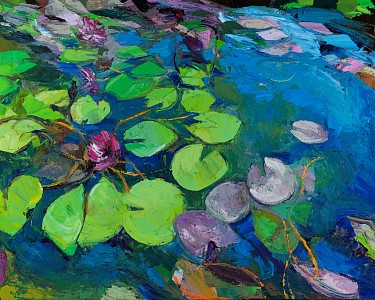
The Picture is the Boogie and I'm the Boogieman: by James Michalopoulos
James Michalopoulos
2019
This essay appeared as the artist’s afterward to Michalopoulos (1997)
I’ve been asked to share some thoughts on my life and work. This is always confronting, as I prefer to approach these questions casually. I do, however, welcome an opportunity like this. It’s an opportunity to self define; to declare myself.
I’m 46, male, American of Greek and Irish extraction. I grew up in New England but have lived for the last 17 years in my adopted home, New Orleans. Additionally, I work several months each year in various cities around the world.
Mostly I paint pictures. My work tends towards the expressionistic. It is gestural, energetic, and colorful. I think there is a quality of movement in most of it. This is due to my ability to sense the pulse of people and objects. I love the lyric that life can be: off-kilter, chaotic, and colorful; a kaleidoscopic unfolding.
I try not to interpret too much because I believe it stifles the work. The picture is a boogie and I’m the boogie man. I am a medium for an inspirational circumstance. I’m on the lookout for the enlivening: my job is to distill and share the resulting essence.
I’m often asked why I distort my images. Architecture is static and rectilinear, in an effort I suspect to control the uncontrollable. There is a natural and effortless movement inherent in all matter. My figurations are a respectful expression of life’s dance. They are a witness to and an expression of the lean of life.
My process is fairly simple: I see something; it strikes me; I’m moved by some aspect; I choose to paint it. Everything has an energy about it, so I try to paint that energy. That energy is the spirit of the subject. If a person or scene is provocative, I want to celebrate that. I celebrate by painting. The painting is a celebration of something which is excitatory, but in my world the painting has a life of its own.
This new emanation of life is self-referential—the painting refers to itself, it is successful or ‘failful’ in its ability to add to the party. Is it curative, palliative, purgative? To stroke the soul is the good? The art enriches or it does not. This art is not good for me because it is an exercise in penmanship politically correct stylizations. This is an exercise in the constructions of the lively. Nutrition is in the belly of the viewer. If your stomach makes you sick, it’s probably a bad burger no matter what the critic says.
My direct experience is my guide. As I work I face the challenge of critiquing and reacting to what emerges on the canvas. I’m willing to begin anew at any time. The presence of spirit rules. The absence of spirit demands that I wake up—that I do whatever is required to recapture the moment or move on. Often I make critical changes in the final moments of work. I know finally that if it doesn’t excite me it won’t excite you either. Why does one painting have life and another not? I think the answer is generally in the character of the artists. You can tell what moves a person by what and how he/she paints. What and how a person celebrates reveals their character. At the heart of this matter lifes an openness to pain and difficulty. To stand in difficulty enables a depth of vision not available to a reflexively comfortable orientation. Our ability to stay the course and face difficulty and uncertainty creates the possibility of insight. An artist has a great capacity for both pain and pleasure.
In practice there are always issues I my life I’m not fully dealing with; issues I avoid: sticky, uncomfortable, difficult situations. They pursue me and I resist. But if I give in, if I face the problem, If I accept relationship, deep occurs. The more I accept my life, the more depth shows up. It’s axiomatic: enter your life and you find depth. Enter your life and you enter the life of the world.
How I am when I work is the work. Am I clear and ready? Am I available even if I’m not ready? The qualities of mind and presence I bring inform the work. I am instrumentality, a committed instrumentality to the brightness of birth and death. I challenge myself to produce work which contributes to life. Am I artful with the challenge? Am I aware of where I am and where I want to go, and am I skillful and respectful in transit? What do I speak to in my work? What do I listen to? Once I settle on something, do I have the character to complete it? Am I committed enough to demand integrity in the work? It is a funny process: to be inspired; express; critique; express.
I think there are several critical qualities in this art process. First, skillful means—the knowledge, technique, and talent—are required. Second, sustained presence to the task is necessary. These qualities are a background to the construction of good art; they are context. And there is a large element of trust in the unfolding of the best work.
So, now, what game will I play? What pictures to paint, issues or opportunities to visit? I want to do it all. For the summer it’s landscapes and figures. I will enjoy architecture, sculpture, and printmaking in the fall and early winter. I will see where life takes me. I’m really glad life has taken me. I’m aware how short life is. The time to strike is now. The question is immediate: how am I and for what?
— James Michalopoulos
